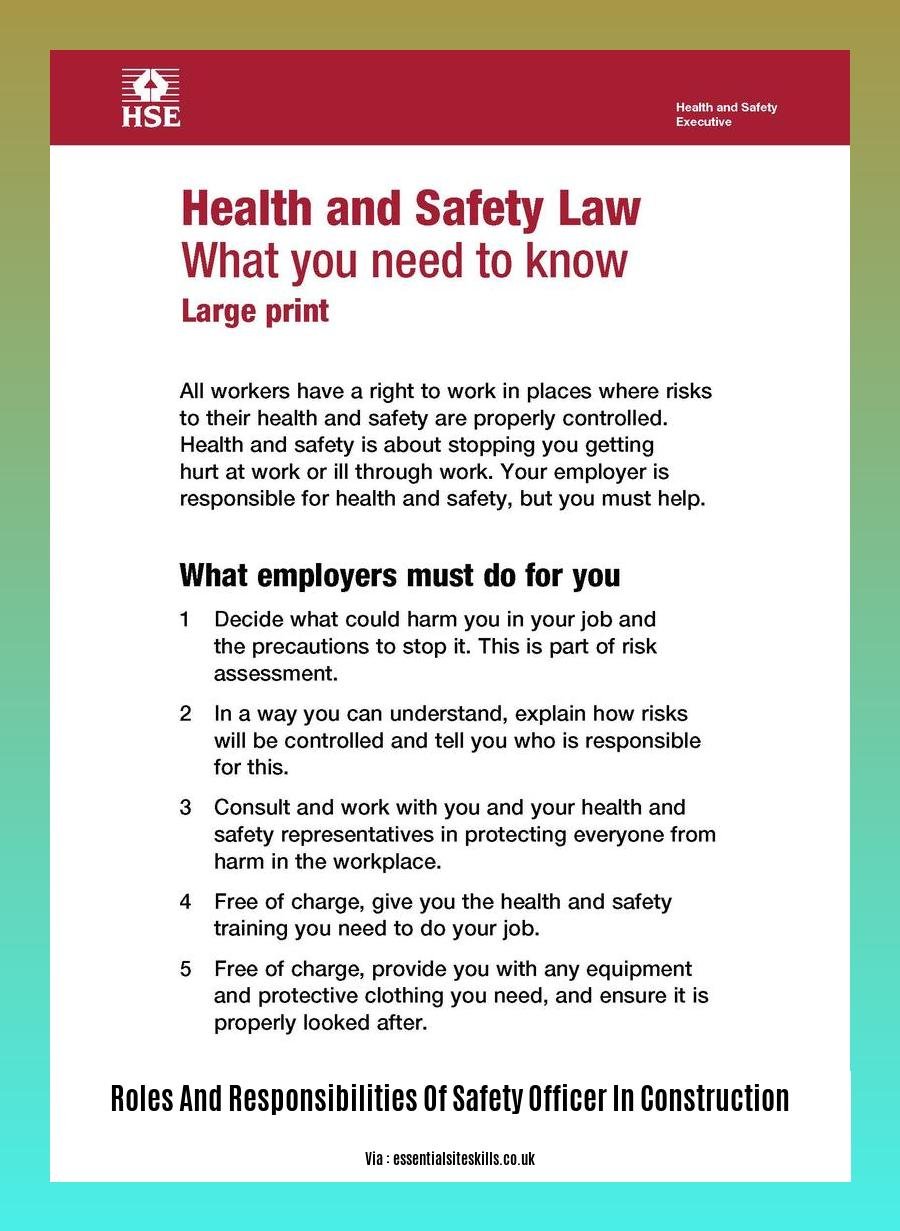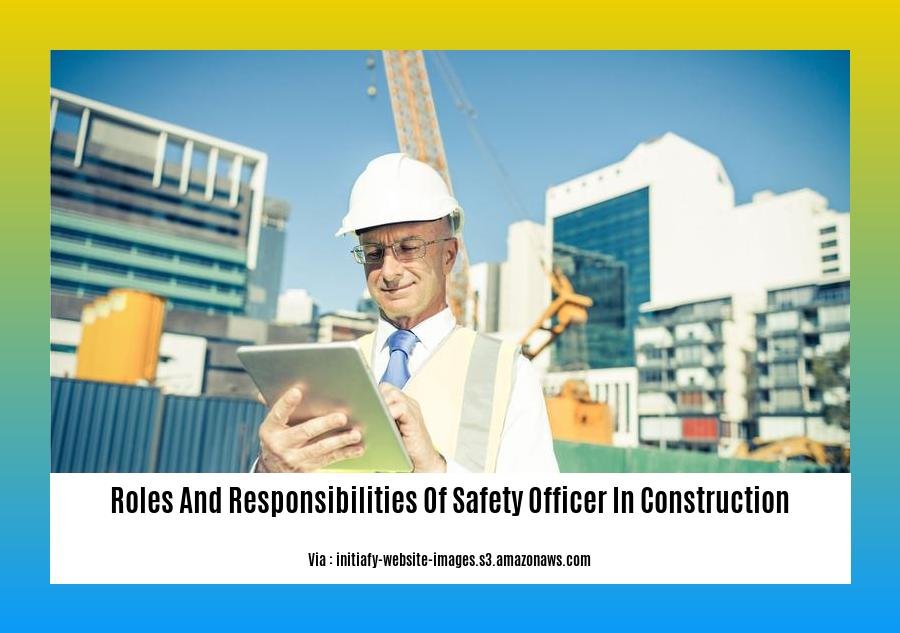The Roles and Responsibilities of a Safety Officer in the Construction Industry: A Comprehensive Guide to Workplace Safety
Key Takeaways:
- Promote worker and visitor safety at construction sites
- Develop and implement safety plans to minimize risks
- Conduct safety inspections and assess potential hazards
- Train personnel on safety protocols and standards
- Investigate incidents and accidents
- Maintain safety records and report incidents
- Ensure compliance with health and safety regulations
Roles and Responsibilities of a Safety Officer in Construction

As a seasoned safety officer in construction, your primary objective is safeguarding the well-being of workers and visitors on construction sites. Your responsibilities encompass:
-
Developing and Implementing Safety Policies: Establish clear protocols to minimize accident risks, ensuring adherence to industry regulations.
-
Conducting Site Inspections and Risk Assessments: Identify potential hazards and implement proactive measures to prevent incidents.
-
Providing Safety Training: Educate workers on safe work practices, regulations, and emergency procedures.
-
Investigating Accidents and Injuries: Thoroughly analyze incidents to determine root causes and recommend corrective actions.
-
Maintaining Safety Records and Reporting Incidents: Document accidents, near misses, and compliance audits, providing valuable data for continuous improvement.
-
Ensuring Compliance with Regulations: Stay abreast of OSHA and industry standards, ensuring that construction projects adhere to legal requirements.
By proactively addressing safety concerns, effectively communicating protocols, and fostering a culture of safety awareness, you play a critical role in protecting lives and assets in the dynamic construction industry.
Did you know that you can learn more about our extensive road construction machinery list if you click on the highlighted link?
We have a comprehensive guide on the rural road construction process that you can access by clicking on the highlighted link.
Safety Inspections and Audits
Safety Inspections and Audits are a crucial aspect of ensuring workplace safety in the construction industry. As a seasoned safety officer, I’ve seen firsthand how regular inspections and audits can significantly reduce accidents and promote a culture of safety awareness.
Key Responsibilities of Safety Inspectors
- Conduct regular workplace inspections, examining structures, machinery, and work environments for potential hazards.
- Document working conditions meticulously, taking detailed notes and photographs to support findings.
- Verify that employers provide adequate protective equipment, ensuring compliance with safety regulations.
- Investigate workplace incidents thoroughly, analyzing root causes and recommending corrective actions.
- Enforce safety regulations diligently, monitoring compliance with OSHA and industry standards.
Benefits of Regular Inspections and Audits
- Reduced accident rates by identifying and addressing potential hazards proactively.
- Improved compliance with regulations, ensuring adherence to safety standards and reducing liability risks.
- Enhanced safety awareness among workers, fostering a culture of safety consciousness.
- Accurate documentation for continuous improvement, allowing for data-driven decision-making and benchmarking.
- Improved productivity, as a safe workplace reduces downtime due to accidents.
Key Takeaways:
- Regular safety inspections and audits are crucial for workplace safety in construction.
- Thorough documentation supports findings and facilitates corrective actions.
- Collaboration between safety inspectors and employers is essential for effective compliance.
- Analysis of workplace incidents helps prevent future occurrences.
- Enforcement of safety regulations ensures compliance and reduces liability.
Sources:
- What Does a Safety Inspector Do? (Indeed)
- Construction Safety Officer: Responsibilities and Duties (NY Engineers)
Safety Training and Awareness

As a seasoned safety officer tasked with ensuring the well-being of my team on construction sites, I’ve seen firsthand the transformative impact of Safety Training and Awareness. It’s not just about ticking boxes; it’s about fostering a culture where every worker feels empowered to prioritize safety.
1. Conduct Regular Tool Box Talks and Site Inspections:
Engage your team in regular briefings to reinforce safe work practices, highlight potential hazards, and address any concerns. Conduct thorough site inspections to identify and mitigate risks before they materialize into accidents.
2. Implement a Comprehensive Safety Training Program:
Provide comprehensive training tailored to the specific hazards of the construction site. This may include topics such as fall protection, equipment handling, and emergency preparedness. Make training interactive and engaging to enhance understanding and retention.
3. Foster a Culture of Safety:
Beyond training, it’s essential to cultivate a safety-conscious mindset throughout the team. Encourage open communication, reward safe behavior, and empower workers to report hazards without fear of retribution.
4. Track Progress and Make Adjustments:
Regularly monitor safety metrics to identify areas for improvement. Analyze incident reports, safety audits, and employee feedback to make data-driven decisions and adjust your training and awareness programs accordingly.
Key Takeaways:
- Safety Training and Awareness are crucial for preventing accidents and ensuring worker well-being.
- Regular Tool Box Talks and Site Inspections identify and address potential hazards.
- A Comprehensive Safety Training Program equips workers with the knowledge and skills to work safely.
- Fostering a Culture of Safety creates a positive work environment where safety is prioritized.
- Tracking Progress and Making Adjustments ensures continuous improvement and safety optimization.
Citations:
– Safety Training in Construction: A Guide to Best Practices
– Construction Safety Officer Responsibilities and Duties
Compliance with OSHA Standards and Regulations
Key Takeaways:
- Understanding OSHA standards is paramount for safety officers.
- Ensuring compliance reduces worksite hazards and improves safety.
- Regular inspections, risk assessments, and training enhance compliance.
- Effective recordkeeping and documentation support compliance efforts.
OSHA (Occupational Safety and Health Administration) regulations are essential guidelines for safeguarding the well-being of construction workers. As a seasoned safety officer, I’ve witnessed firsthand how compliance with OSHA Standards and Regulations fosters a safer and more productive work environment.
Step-by-Step Guide to Compliance
-
Become familiar with OSHA standards: Study the OSHA Field Operations Manual and relevant codes specific to the construction industry.
-
Conduct regular site inspections: Identify and assess potential hazards, ensuring compliance with OSHA standards.
-
Develop and implement safety plans: Create site-specific plans outlining safety protocols and emergency response measures.
-
Provide comprehensive safety training: Train workers on safety procedures, hazard recognition, and proper equipment use.
-
Establish a system for incident reporting and investigation: Promptly address accidents and near misses to identify root causes and prevent recurrence.
-
Maintain accurate safety records: Document safety inspections, training logs, and incident reports for compliance and continuous improvement.
-
Coordinate with stakeholders: Collaborate with management, contractors, and workers to ensure everyone is informed and adhering to safety standards.
Benefits of Compliance
Adherence to OSHA regulations brings numerous benefits:
- Protects worker safety and well-being
- Reduces workplace incidents and accidents
- Improves productivity and efficiency
- Enhances company reputation
- Avoids costly fines and legal liabilities
Conclusion
By adhering to OSHA Standards and Regulations, safety officers play a vital role in creating a safe and compliant work environment in the construction industry. Embracing these guidelines is not only a legal obligation but also an ethical responsibility that safeguards the well-being of workers and fosters a culture of safety on construction sites.
Relevant Sources:
- OSHA Safety and Health Program Management Guidelines
- OSHA Standards: A Guide to Health and Safety Compliance
FAQ
Q1: What are the primary responsibilities of a Safety Officer in the construction industry?
Q2: How does a Safety Officer ensure worker and visitor safety at construction sites?
Q3: What are the key elements of a comprehensive safety program developed by a Safety Officer?
Q4: How does a Safety Officer contribute to a positive safety culture within construction projects?
Q5: What training and qualifications are typically required for a Safety Officer in the construction industry?
- Annapolis Mall Map & Directory: Find Stores, Restaurants & More - March 29, 2025
- Angel of Harmony Statue Vandalized at St. Louis Cathedral Basilica - March 29, 2025
- Amur River Maple ( Acer ginnala): A Comprehensive Guide (Including Invasiveness) - March 29, 2025










